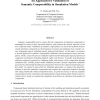167 search results - page 16 / 34 » Querying Temporal Constraint Networks: A Unifying Approach |
CVPR
2004
IEEE
14 years 9 months ago
2004
IEEE
We present Propagation Networks (P-Nets), a novel approach for representing and recognizing sequential activities that include parallel streams of action. We represent each activi...
MM
2006
ACM
14 years 1 months ago
2006
ACM
Conventional wide-area video surveillance systems use a network of fixed cameras positioned close to locations of interest. We describe an alternative and flexible approach to w...
CVPR
2009
IEEE
14 years 2 months ago
2009
IEEE
While video-based activity analysis and recognition has received much attention, existing body of work mostly deals with single object/person case. Coordinated multi-object activi...
IWANN
2009
Springer
14 years 2 months ago
2009
Springer
Generating test data for formal state based specifications is computationally expensive. This paper improves a framework that addresses this issue by representing the test data ge...
PADS
2009
ACM
14 years 2 months ago
2009
ACM
Semantic composability aims to ensure that the composition of simulation components is meaningful in terms of their expressed behavior, and achieves the desired objective of the n...

